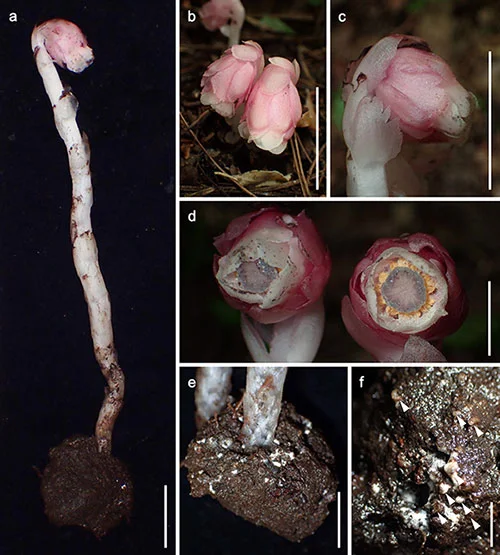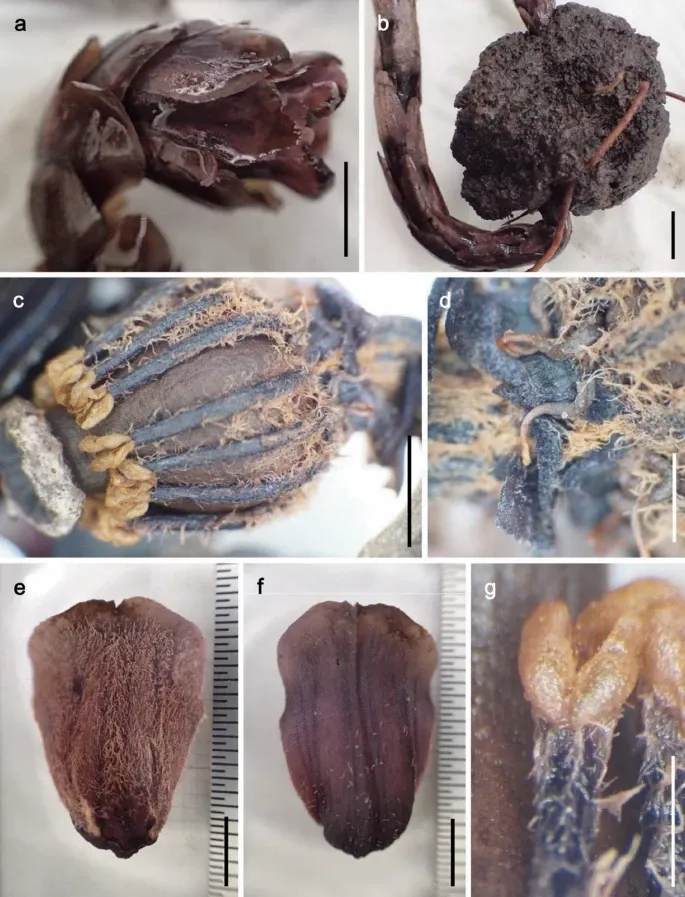Ethereal color variant of mysterious plant is actually a new species | Research at Kobe

Figure 1. Morphological comparison of the aboveground parts of M. kirishimense and M. humile:
(a-c) M. kirishimense, (d-e) M. humile, (f). M. humile f. roseum (color variant of M. humile). The arrowheads indicate spreading sepals.
(a-c) M. kirishimense, (d-e) M. humile, (f). M. humile f. roseum (color variant of M. humile). The arrowheads indicate spreading sepals.
Photographed by Masayuki Sato (a), Katsumi Iwahori (b), Shuichi Kurogi (c), Shin Terui (d), Kazushige Uemori (e), and Kenji Suetsugu (f).
The new species is the rosy pink form of the parasitic plant known to science as Monotropastrum humile. These plants as found throughout the woods of East and Southeast Asia and have lost their ability to photosynthesise, depending instead on the hyphae of soil fungi which are themselves in a symbiotic relationship with other plants. These soil fungi connect to the roots of other plants and help breakdown organic molecules in the soil into nutrients the plans can use. In return the plants supply the fungi with the sugars they produce in their leaves. Monotropastrum humile however, is a free loader on this system and not only takes the nutrients but also the sugars, while giving nothing in return.
But it's not this parasitic relationship which is under consideration here, but the newly-discovered status of the rosy pink form, which close examination and 20 years of study have shown to be a different species. The Kobe University scientists who identified it as a new species have named it M. kirishimense, after Kirishima, in Kagoshima Prefecture, Japan, where it was first found growing.
From the Kobe University news release:
Green leaves and photosynthesis were once considered essential characteristics of plants. However, some plants have stopped performing photosynthesis and take the nutrients they need from other organisms instead. One such mycoheterotrophic plant is ghostly-looking Monotropastrum humile that is widely found across East and Southeast Asia. It often grows in woodlands where there is little sunlight, obtaining the nutrients it needs by feeding off the hyphae of fungi. Despite its wide distribution, it was previously believed that only one species of this plant existed in the world. However, Professor SUETSUGU Kenji and colleagues have discovered that a variant found in Japan is actually a new species, shaking up our understanding of this unusual-looking genus of plants.Of particular note here are the mechanisms the authors suggest for this speciation to occur and be maintained. Firstly, there is resource sharing, then there is a prezygotic barrier to hybridization by different flowering times, such as arise when hybridization produces individuals which are not adapted to either of the specialised niches of the parent species, or which are sterile or fail to develop.
It has rosy pink petals and stems resembling milk glass, giving it a beautiful, otherworldly appearance. As it was first found around Kirishima in Kagoshima Prefecture, Japan, the new species has been named Monotropastrum kirishimense.
Originally, this new species was tentatively treated as a color variant of M. humile, known as M. humile f. roseum. Thus began an extensive and multifaceted 20-year study to determine how exactly these plants differed. Specimens were collected from throughout Japan and Taiwan, as well as Vietnam. Results of various analyses revealed morphological differences (Figures 1-3), including the following; M. kirishimense flowers and ovaries are more rounded than those of M. humile, and its rootball is more obscured by the surrounding soil (in contrast to M. humile’s protruding root tips). M. kirishimense individuals are shorter above ground (under 5cm) and longer below ground (over 10cm). The flowering season is different too; M. humile flowers bloom approximately 40 days earlier than M. kirishimense. As the two plant species have the same primary pollinator (the bumblebee Bombus diversus), this difference in flowering times can reduce heterospecific pollen deposition, helping to ensure conspecific mating, and thereby preventing them from producing hybrids.
Fig 2.
Monotropastrum humile and its monotropoid association found at the M. kirishimense type locality (on June 25, 2019, except for the flowering plants). a Flowering plants (on May 17, 2019). Arrowheads indicate spreading sepals. b Fruiting plant. c Fruiting scapes with root ball. d, e Magnification of the root ball. Root tips and branching are easily recognizable. Arrowheads indicate root tip apices. Scale bars: 3 cm (a–c), 1 cm (d), and 5 mm (e).Photographed by Hideo Shimada (a) and Kenji Suetsugu (b–e)Fig. 3.
Monotropastrum kirishimense and its monotropoid association (holotype). a Flowering scape with root ball. b, c Flowering plants. d Flowers, top view. e, f Magnification of the root ball. Root tips are not apparent, but white fungal hyphae are visible. Arrowheads indicate the root tip apices. Scale bars: 3 cm (a–c), 1 cm (d, e), and 5 mm (f).Photographed by Kenji SuetsuguThere are several other possible reasons why M. kirishimense and M. humile may have evolved into separate species. One possibility is that they have become specialized in feeding on different fungi, which has led to reproductive isolation, or the inability to produce offspring together. This process is known as resource partitioning and is one of the major ways that species can evolve from a common ancestor. Genetic analysis of mycobionts revealed that M. kirishimense has a consistent, specialized association with a particular lineage of fungi, whereas M. humile is associated with different lineages (Figure 4). Therefore, this study suggests that M. kirishimense may have evolved into a new species by relying on a specific type of fungus. In fact, the phylogenetic tree (a ‘family tree’ of the evolutionary history of a group of organisms) of the plants themselves shows that the genetic characteristics of M. kirishimense and M. humile can be separated into two clades (Figure 5). Based on the researchers’ analysis of various characteristics, it has been revealed that M. kirishimense is distinct from M. humile in terms of its appearance, flowering patterns, evolutionary history, and ecological relationships. Therefore, the researchers concluded that it should be recognized as an independent species.Fig 4.
Monotropastrum kirishimense (holotype). a Flower. b Root ball with the interpenetrating Pinus densiflora root system. c Flower with perianth removed. d Floral discs with the basal part of the filaments and protrusions from the floral disc. e Petal, adaxial view. f Petal, abaxial view. g Anther. Scale bars: 1 cm (a, b), 5 mm (c, e, f), and 2 mm (d, g).Photographed by Kumi Hamasaki
Overall, the research group not only revealed that M. kirishimense is a distinct species but also deepened understanding of plants in the Monotropastrum genus. Mycohetrotrophic plants are very vulnerable to extinction as they rely on specific ecosystems to survive and are usually found in old-growth forests. The newly recognized species, M. kirishimense, is rare and presumably endangered. Now that it has been identified as a new species, conservation efforts can be made to protect it. This study emphasizes the importance of combining various analysis methods, called integrative taxonomy, to fully understand and protect biodiversity. This work was conducted by a multi-institutional research group, including Professor Suetsugu (Graduate School of Science, Kobe University), Professor SUYAMA Yoshihisa (Graduate School of Agricultural Science, Tohoku University), and Dr. Tian-Chuan Hsu (Taiwan Forestry Research Institute). The paper was published online in Journal of Plant Research on November 30, 2022.
The scientists have published their findings open access in the Journal of Plant Research:
AbstractIt really goes almost without saying that there is no evidence whatsoever in this paper, as in almost all papers published in the last 160 years, that the scientists are having any difficulty fitting the observations into an evolutionary framework or that the TOE is not fit for purpose, nor that a Bronze Age superstition involving magic is a better scientific explanations for what can be observed.
Due to their reduced morphology, non-photosynthetic plants have been one of the most challenging groups to delimit to species level. The mycoheterotrophic genus Monotropastrum, with the monotypic species M. humile, has been a particularly taxonomically challenging group, owing to its highly reduced vegetative and root morphology. Using integrative species delimitation, we have focused on Japanese Monotropastrum, with a special focus on an unknown taxon with rosy pink petals and sepals. We investigated its flowering phenology, morphology, molecular identity, and associated fungi. Detailed morphological investigation has indicated that it can be distinguished from M. humile by its rosy pink tepals and sepals that are generally more numerous, elliptic, and constantly appressed to the petals throughout its flowering period, and by its obscure root balls that are unified with the surrounding soil, with root tips that hardly protrude. Based on genome-wide single-nucleotide polymorphisms, molecular data has provided clear genetic differentiation between this unknown taxon and M. humile. Monotropastrum humile and this taxon are associated with different Russula lineages, even when they are sympatric. Based on this multifaceted evidence, we describe this unknown taxon as the new species M. kirishimense. Assortative mating resulting from phenological differences has likely contributed to the persistent sympatry between these two species, with distinct mycorrhizal specificity.
Suetsugu, Kenji; Hirota, Shun K.; Hsu, Tian-Chuan; Kurogi, Shuichi; Imamura, Akio; Suyama, Yoshihisa
Monotropastrum kirishimense (Ericaceae), a new mycoheterotrophic plant from Japan based on multifaceted evidence
Journal of Plant Research (2022). DOI: 10.1007/s10265-022-01422-8
Copyright: © 2022 The authors.
Published by Springer Nature Switzerland AG. Open access
Reprinted under a Creative Commons Attribution 4.0 International license (CC BY 4.0)
All in all, just another casual refutation of another frequent Creationist lie.






No comments :
Post a Comment
Obscene, threatening or obnoxious messages, preaching, abuse and spam will be removed, as will anything by known Internet trolls and stalkers, by known sock-puppet accounts and anything not connected with the post,
A claim made without evidence can be dismissed without evidence. Remember: your opinion is not an established fact unless corroborated.